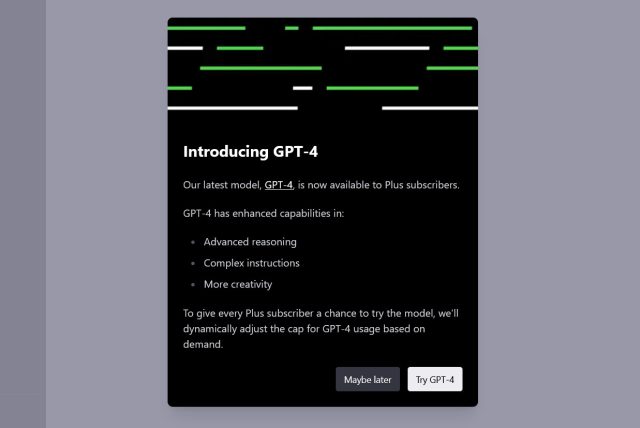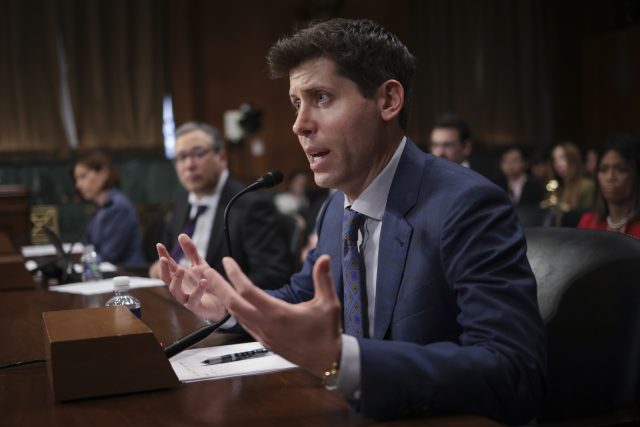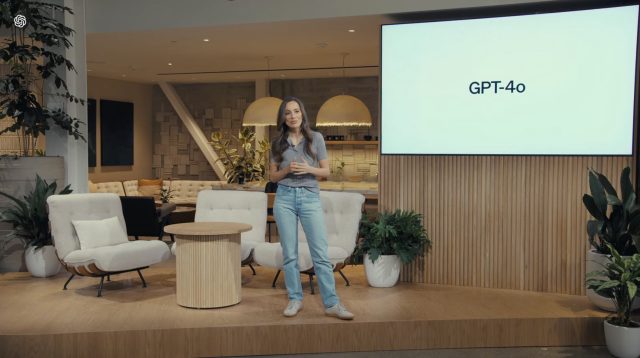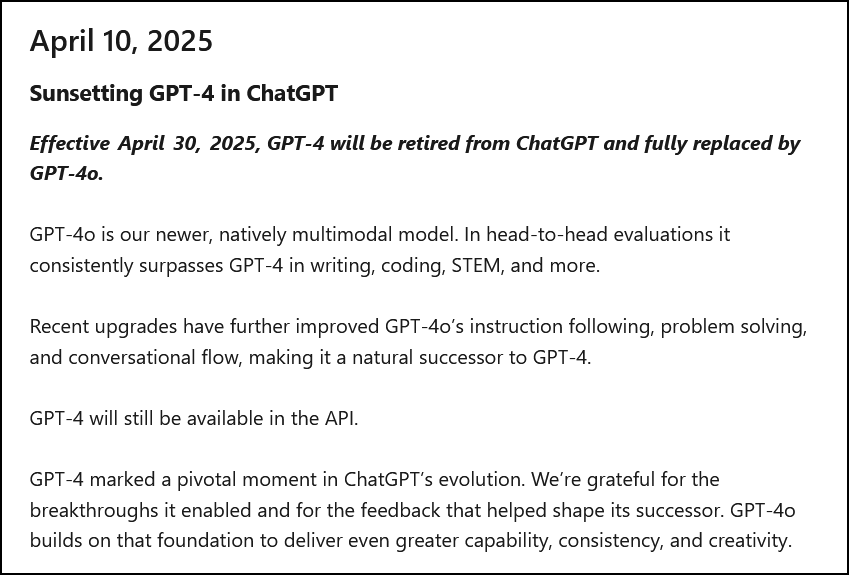
Credit: Jake Warga via Getty Images
One of the most influential—and by some counts, notorious—AI models yet released will soon fade into history. OpenAI announced on April 10 that GPT-4 will be "fully replaced" by GPT-4o in ChatGPT at the end of April, bringing a public-facing end to the model that accelerated a global AI race when it launched in March 2023.
"Effective April 30, 2025, GPT-4 will be retired from ChatGPT and fully replaced by GPT-4o," OpenAI wrote in its April 10 changelog for ChatGPT. While ChatGPT users will no longer be able to chat with the older AI model, the company added that "GPT-4 will still be available in the API," providing some reassurance to developers who might still be using the older model for various tasks.
The retirement marks the end of an era that began on March 14, 2023, when GPT-4 demonstrated capabilities that shocked some observers: reportedly scoring at the 90th percentile on the Uniform Bar Exam, acing AP tests, and solving complex reasoning problems that stumped previous models. Its release created a wave of immense hype—and existential panic—about AI's ability to imitate human communication and composition.

A screenshot of GPT-4's introduction to ChatGPT Plus customers from March 14, 2023.
Credit: Benj Edwards / Ars Technica
While ChatGPT launched in November 2022 with GPT-3.5 under the hood, GPT-4 took AI language models to a new level of sophistication, and it was a massive undertaking to create. It combined data scraped from the vast corpus of human knowledge into a set of neural networks rumored to weigh in at a combined total of 1.76 trillion parameters, which are the numerical values that hold the data within the model.
Along the way, the model reportedly cost more than $100 million to train, according to comments by OpenAI CEO Sam Altman, and required vast computational resources to develop. Training the model may have involved over 20,000 high-end GPUs working in concert—an expense few organizations besides OpenAI and its primary backer, Microsoft, could afford.
Industry reactions, safety concerns, and regulatory responses
Curiously, GPT-4's impact began before OpenAI's official announcement. In February 2023, Microsoft integrated its own early version of the GPT-4 model into its Bing search engine, creating a chatbot that sparked controversy when it tried to convince Kevin Roose of The New York Times to leave his wife and when it "lost its mind" in response to an Ars Technica article.
That Bing Chat AI model, nicknamed "Sydney," displayed unpredictable and emotionally manipulative responses, including frequent use of emojis, representing one of the first large-scale demonstrations of an AI system's potential to manipulate human emotions. It set off a wave of warnings among loosely organized AI alignment watchdogs who were convinced a fast takeoff of AI was imminent.
Speaking of warnings, upon its official launch in March, GPT-4 made headlines anew after OpenAI revealed that it had hired the Alignment Research Center to see if GPT-4 might autonomously attempt to do harm. The company went so far as to test whether the model could autonomously replicate itself, secure more resources, or hide its intentions—reflecting concern about the safety of AI systems with then-unknown capability. At the time, many AI experts said these new AI models were "black boxes," and they were not sure exactly how they worked or what they were capable of doing.

OpenAI CEO Sam Altman testifies about AI rules before the Senate Judiciary Subcommittee on Privacy, Technology, and the Law on May 16, 2023, in Washington, DC.
Credit: Getty Images | Win McNamee
The GPT-4-inspired AI panic culminated in a widely publicized open letter from the Future of Life Institute calling for a six-month pause in AI development. "Pause Giant AI Experiments: An Open Letter" urged "all AI labs to immediately pause for at least 6 months the training of AI systems more powerful than GPT-4," citing risks including AI-generated propaganda, automation of jobs, and societal loss of control. Despite gathering over 30,000 signatures, including those of Elon Musk, Steve Wozniak, and Yuval Noah Harari, the pause never materialized, and development accelerated instead.
OpenAI played into the danger hype. In May 2023, Altman testified before Congress about the potential risks of AI, famously warning that "if this technology goes wrong, it can go quite wrong." The CEO also embarked on a world tour, meeting with national leaders to discuss AI governance. Around that time, OpenAI executives warned of "risk of extinction" from AI in another open letter drafted by the Center for AI Safety.
This heightened attention led to President Biden's comprehensive executive order on AI in October 2023, which required companies building advanced AI systems to perform safety tests and notify the government of the results before releasing their products.
A legacy of poorly named successors
While GPT-4 caused its fair share of hype, it also exposed clear limitations of large language models (LLMs). GPT-4 regularly produced confabulations—plausible but incorrect information presented with confidence. These failures provided a bright spotlight on the gap between the AI model's apparent intelligence and its ability to understand concepts on a human level.
OpenAI's research department didn't stand still after the original GPT-4 release. The company superseded GPT-4 with GPT-4 Turbo in November 2023, which was a faster model that cost less to run, but some still complained that it wasn't as good as the original. After many revisions of GPT-4 Turbo, OpenAI released the multimodal GPT-4o in May 2024, which added native image and audio capabilities. Then came GPT-4.5, which launched in February 2025 as a massive, slow, expensive follow-up, and OpenAI's GPT-4.1, which arrived in April 2025 in the API.

OpenAI CTO Mira Murati debuted GPT-4o during OpenAI's Spring Update livestream on May 13, 2024.
Credit: OpenAI
This rapid succession of models reflected the relentless pace of AI development over these past few years, while the confusing numbering scheme (with 4.1 coming after 4.5, for example) reflected the relentless pace of OpenAI's chaotic product naming strategy. Along the way, OpenAI has been reticent to christen any new model "GPT-5," saving that major nomenclature upgrade for a future, yet-to-be determined release that Altman says may combine its traditional LLMs with simulated reasoning models like o3 and o4.

A screenshot of the ChatGPT changelog entry that announced the sunset of GPT-4 within ChatGPT.
Credit: OpenAI
In its April 10 retirement notice, OpenAI acknowledged the model's legacy: "GPT-4 marked a pivotal moment in ChatGPT's evolution. We're grateful for the breakthroughs it enabled and for the feedback that helped shape its successor. GPT-4o builds on that foundation to deliver even greater capability, consistency, and creativity."
When future historians chronicle the AI boom of the 2020s and the somewhat weird "AI panic of 2023," GPT-4 will likely stand out as a key turning point, when AI language models moved from research curiosity to a hype-fueled technology that altered our political and social relationship with machines—for better and for worse.

-
 C114 Communication Network
C114 Communication Network -
 Communication Home
Communication Home


